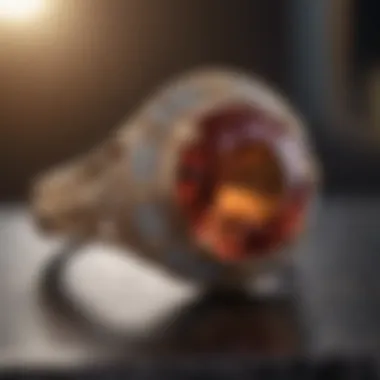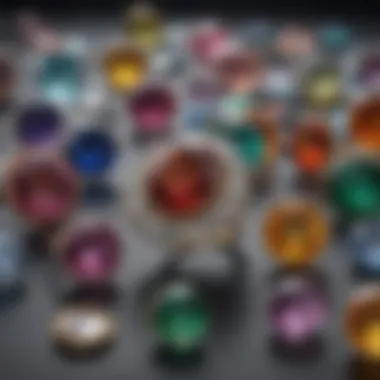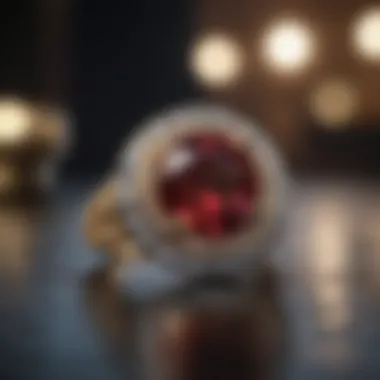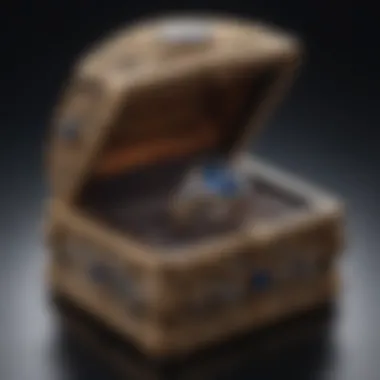Understanding Ring Prices: Key Insights and Factors


Intro
Understanding the cost of a ring, especially one that prominently features gemstones, can be complex. Various factors come into play, from the type of gemstone used to market trends. This section aims to set the stage for a more detailed exploration of these elements, ensuring that the reader grasps the financial implications of their purchase while also appreciating the inherent value of each piece.
To empower both novice buyers and seasoned collectors, we delve into specific aspects like gemstone characteristics, historical significance, and market dynamics. By analyzing these elements, readers will cultivate a more nuanced understanding, which will aid them in making informed decisions.
Gemstone Overview
In the realm of jewelry, gemstones are both prized and mystifying. They come in various types, each with its own unique set of qualities and characteristics. Understanding these can directly influence purchasing choices and the perceived value of a ring.
Definition and Characteristics
Gemstones are naturally occurring minerals or rocks that have been cut and polished for use in jewelry. Their allure often stems from their brilliance, durability, and rarity. Characteristics such as clarity, cut, color, and carat weight greatly influence their valuation. Each stone possesses distinct features:
- Color: The hue can vary widely, affecting the desirability and price.
- Clarity: Fewer inclusions or blemishes typically lead to higher values.
- Cut: A well-executed cut enhances a gemstone’s brilliance, affecting aesthetics and price.
- Carat Weight: Heavier stones are rarer and thus often more expensive.
Classification of Gemstones
Gemstones can be broadly classified into precious and semi-precious categories. Precious stones like diamonds, rubies, sapphires, and emeralds are often more sought after due to their rarity and exceptional qualities. On the other hand, semi-precious stones, such as amethysts, garnets, and turquoise, offer diversity and unique beauty at usually lower price points.
Important Note: Collectors should consider both form and function when selecting a gemstone for their ring, as personal taste often dictates which classification best fits an individual's preferences.
Historical Significance
The allure of gemstones goes beyond their physical properties. Throughout history, they have held significant cultural and personal value. Understanding this context enhances appreciation for the material itself and provides insight into market trends.
Ancient Uses and Cultural Importance
From ancient civilizations to modern-day society, gemstones have played pivotal roles. They were often seen as talismans, believed to possess protective and healing powers. Cultures used stones for adornment in ceremonies, rituals, and as status symbols.
Myths and Legends Surrounding Gemstones
Numerous myths and legends have arisen around gemstones, further embedding them into human culture. For instance, diamonds were often considered a symbol of strength and invincibility, while sapphires were associated with wisdom and royalty. Such stories contribute not only to their mystique but also to their market appeal.
The interplay of these historical narratives and the modern marketplace adds layers to the purchasing process of rings and their embedded gemstones. In sum, a deeper understanding of both the gemstones themselves and their storied past equips buyers with a more informed perspective on value and cost.
Understanding the Basics of Ring Pricing
Understanding the fundamentals of ring pricing is essential for anyone interested in acquiring a ring, whether for emotional significance or as an investment. This segment lays a foundation for readers to comprehend how various elements converge to form the overall price of a ring.
An informed buyer weighs several factors, such as the kind of gemstone, crafted design, and metal type. Each of these aspects can dramatically shift the cost, presenting a multifaceted landscape of considerations and choices. This understanding allows buyers to align their preferences with their budgetary constraints while making educated choices.
Moreover, recognizing how the ring market operates can lead to more deliberate purchases. People who grasp these basics are less likely to fall victim to impulse buying or common misconceptions. They can analyze cost in terms of quality, rather than simply choosing based on price. This article aims to empower readers, from novice buyers to experienced collectors, by dissecting each element that contributes to the price of a ring.
The Importance of Setting a Budget
Setting a budget is often the first step in the journey towards purchasing a ring. It serves as a guiding parameter that narrows one’s options while allowing for a wide array of choices within one’s financial reach. Without a budget, buyers may find themselves overwhelmed by the plethora of options available in the jewelry market.
A well-defined budget enhances decision-making processes, allowing for clearer prioritization. It encourages potential buyers to think critically about their needs and desires. For instance, one may have to weigh whether they want a larger gemstone or higher quality in grading. A budget prompts this kind of reflection and deliberation.
Additionally, acknowledging how much one is willing to spend can help avoid unnecessary stress. Taking control of finances fosters a sense of empowerment, leading to a more fulfilling purchasing experience. Moreover, a budget helps in assessing the long-term value of the ring. By focusing on investments that maintain worth, buyers can make informed choices that are satisfactory on both emotional and fiscal levels.
Common Pricing Myths
Several myths circulate in the realm of ring pricing, often misguiding potential buyers. One prevalent myth is that a higher price always correlates with superior quality. While high prices can signal fine craftsmanship and materials, they are not an exclusive marker of quality. Knowledge of grading systems—like that used for diamonds—should guide buyers more than just the price tag.
Another common misconception is that all gemstones appreciate in value. In reality, many factors influence a gemstone's resale value, including market demand and unique characteristics. Buyers should research specific gemstones they are interested in to understand their market behaviors better.


Lastly, many people believe that purchasing a ring online compromises security. While some online retailers may lack transparency, reputable sites offer certifications and detailed imagery. It is crucial to assess sellers carefully, regardless of their physical or online presence.
Understanding the myths surrounding ring pricing can better equip buyers to navigate the complexities of the jewelry market successfully. By debunking these misconceptions, individuals can approach their purchases with greater confidence and clarity.
Factors That Influence Ring Prices
Understanding the factors that influence ring prices is crucial for anyone interested in purchasing a ring. It helps buyers make informed decisions and ensures that they understand what they are paying for. The value of a ring does not solely depend on its price tag; it also involves elements like the type of gemstone used, the quality of the materials, and the overall design. By considering these factors, one can gauge not only the cost but also the intrinsic value of the piece.
Type of Gemstone
The gemstone is often the most critical aspect of a ring’s price. Different gemstones, such as diamonds, sapphires, and emeralds, vary widely in value. For example, diamonds are generally more expensive due to their popularity and rarity, while more common stones like amethyst can be much more affordable. The choice of gemstone influences not just the initial cost but also the ring's long-term value.
Quality and Grading
Quality and grading influence how a gemstone is perceived and valued in the market. This aspect is often broken down into several characteristics such as color, clarity, cut, and carat weight.
Color
Color is a significant factor in determining the value of colored gemstones. For example, a vivid blue sapphire is typically valued higher than a pale one. The key characteristic of color in gemstones involves its hue, saturation, and tone. A rich and even color is desirable. However, consumers should note that some colors are more sought after and therefore may come with a higher price.
Clarity
Clarity refers to the presence of inclusions or blemishes within a gemstone. A stone with high clarity will command a higher price. The key characteristic of clarity is how free the stone is from visual flaws. Clarity becomes an essential factor, especially for diamonds, as consumers prefer stones that are flawless or near-flawless. A high-clarity diamond can greatly increase the ring's value.
Cut
The cut of a gemstone affects how it interacts with light. An expertly cut stone can exhibit brilliance and sparkle, elevating its visual appeal and price. The key characteristic of cut is how well the facets enhance the stone's appearance. It is important since even a high-quality stone can look dull if not cut properly. Thus, investing in a well-cut gemstone is often considered wise.
Carat Weight
Carat weight corresponds to the size of the gemstone. Typically, larger stones command higher prices. The key characteristic of carat weight is that it is a measure of weight, not size. However, two stones of equal carat weight can differ significantly in price based on quality and other factors. This makes carat weight a major consideration in pricing.
Metal Choice
The choice of metal on which a gemstone is set also plays a significant role in determining the overall cost of a ring.
Gold
Gold is popular for its aesthetic value and durability. The type of gold used, whether it is yellow, white, or rose, and its karat level (e.g., 14K, 18K) can significantly affect the price. Gold has a timeless appeal but can be prone to scratches over time. Balancing the gold's quality with its cost is essential for buyers.
Platinum
Platinum is often regarded as a premium metal because of its rarity and strength. Its density lends a hefty feel, making it highly desirable for rings. However, it usually comes with a higher price tag. One unique feature is that platinum does not tarnish easily, which means it will maintain its appearance over time. Customers looking for durability often gravitate towards platinum despite the cost.
Silver
Silver is a more affordable option compared to gold and platinum. It is often used in various jewelry designs but may tarnish over time when exposed to air and moisture. While it is a budget-friendly choice, its susceptibility to tarnish can be a disadvantage. Silver can suit certain designs well but requires regular maintenance to keep it looking good.
Design Complexity
The complexity of the ring's design also impacts its price. Intricate and unique designs usually come with a higher price due to the time and skill required to create them. A simple band will often be more affordable compared to a ring with multiple stones or detailed metalwork. When considering design complexity, buyers should evaluate how the style aligns with their vision and budget.
Market Trends Influencing Prices
Understanding market trends is essential for anyone interested in purchasing a ring. These trends shape the pricing landscape significantly. Insights into these fluctuations can lead to better purchasing decisions. Buyers can benefit from knowing the current sentiments in the jewelry market.
Market trends have several elements to consider. Economic factors, such as supply and demand, greatly impact the prices of gemstones and metals. When demand increases, prices tend to rise. If supply decreases, buyers may face higher costs. Keeping track of these trends can help buyers evaluate when to buy to get the best value for their money.


Global Market Fluctuations
Global market fluctuations play a crucial role in determining the price of rings. These fluctuations often stem from economic conditions, geopolitical events, and trade policies that influence the availability of gemstones and precious metals. For example, fluctuations in the stock market can affect discretionary spending. When investors are wary, spending on luxury items, like rings, may decline, leading to a drop in prices.
Moreover, international supply chains are essential for ring production. Disruptions in mining locations can create shortages. For instance, if a country faces political turmoil or a natural disaster, it may halt gemstone exports. These shortages drive prices higher due to scarcity.
Recent trends also show the rise of synthetic gemstones. These lab-created alternatives often offer lower prices and can affect the sales of natural stones. However, buyers should consider the long-term appreciation of natural gemstones, which typically hold higher value over time compared to synthetic options.
Changing Consumer Preferences
Consumer preferences are continually evolving, impacting ring prices. The shift towards sustainability has changed how buyers view gemstones. Increasing awareness of ethical sourcing practices leads to demand for conflict-free and responsibly mined stones. This shift can elevate prices for ethically sourced items compared to traditionally sourced gems.
Customization is another critical factor. As more people seek unique and personalized pieces, jewelers are adjusting their offerings. Custom-designed rings often come with higher price tags due to the intricate work involved and the time required for creation. Buyers today might be willing to pay more for uniqueness and personal significance, further influencing prices.
In addition, trends in fashion influence how consumers perceive value in rings. Styles from celebrity endorsements or fashion shows can spur interest in specific gemstones or designs, leading to spikes in demand and prices.
Overall, by understanding these trends, buyers can make more informed decisions about when and how to purchase their rings. Tracking these market influences is vital for acquiring beauty while ensuring investment potential.
Personal Considerations for Purchasing
When it comes to buying a ring, personal considerations hold significant weight. These factors are often deeply intertwined with emotional and practical aspects of the purchase. Understanding the personal significance attached to a ring can profoundly influence your selection process, from gem choice to design.
Meaning and Symbolism
The meaning and symbolism of a ring are pivotal. Rings often represent milestones, relationships, or personal values. For many, an engagement or wedding ring is not merely a piece of jewelry; it embodies a shared commitment and love.
Consider the symbolism of the gemstone you choose. For example, diamonds are traditionally linked with eternal love, while sapphires can denote fidelity and sincerity. The color, cut, and clarity of the gemstone also play a role in enhancing its significance.
A thoughtful consideration of these elements ensures that the ring's sentiment aligns with your intentions. This mindful approach adds to the emotional value, fostering a deeper connection with the piece. The story behind the ring—the reason for its purchase—should be as memorable as the occasion it commemorates.
Lifetime Value of a Ring
Assessing the lifetime value of a ring extends beyond its initial cost. Rings can be seen as long-term investments, particularly those that include high-quality gemstones. Over time, the value of certain pieces can appreciate, making them a financial asset as well as a sentimental one.
There are several factors to consider regarding a ring's lifetime value:
- Material Quality: Rings made of precious metals like platinum or gold tend to last longer and maintain their condition better than those made from lesser materials.
- Gemstone Resale Value: Some gemstones have intrinsic value based on their rarity and demand in the market. Research into the market trends of specific gemstones can aid in understanding their potential appreciation.
- Timeless Design: A classic design often retains attractiveness over time, making it more desirable in the long run compared to trends that may fade.
Investing time in understanding these aspects can help you to enhance the lifetime value of a ring. Furthermore, such a thorough consideration assures that you make an informed decision, thus maximizing not only personal satisfaction but also potential financial benefits.
"Choosing a ring should reflect both the buyer's personality and the story they want to tell."
In summary, personal considerations are essential when purchasing a ring. Evaluating the meaning and lifetime value can ensure that the choice aligns with both emotional and financial expectations.
Tips for Buying a Ring
Buying a ring is a significant event, whether for an engagement, anniversary, or personal indulgence. The process can be overwhelming, given the multitude of options and factors involved. Hence, understanding the core aspects can lead to a more satisfying purchase experience. This guide outlines essential tips, focusing on thoroughly researching gemstone options, collaborating with trusted jewelers, and evaluating value versus price to ensure a sound investment that brings joy and meaning.
Researching Gemstone Options
Researching gemstone options is fundamental to making an informed decision. Various gemstone types come with different characteristics, each influencing not only beauty but also price. For instance, diamonds remain the most traditional choice, celebrated for their hardness and brilliance. However, alternatives like sapphires, emeralds, or even lab-created stones offer unique aesthetics and may provide better value.
When examining gemstones, consider the following aspects:
- Color: Vibrant colors often command higher prices. Undertaking a comparison between shades can assist in identifying the ideal choice.
- Clarity: Fewer inclusions or blemishes can increase a stone’s value. Understand the grading system to discern quality.
- Cut: The way a gem is cut affects its sparkle and brilliance. Familiarize yourself with these styles to see what appeals most.
- Carat Weight: Larger stones tend to be more expensive, but sometimes smaller, high-quality stones can make just as much of an impact.
Utilizing online resources can facilitate your research. Websites like en.wikipedia.org provide a deep dive into gemstone properties and trends, enhancing your understanding of what you may be considering.


Working with Trusted Jewelers
Selecting the right jeweler is crucial in the purchase journey. A trusted jeweler can offer insights into quality that might not be immediately obvious. Ensure that the jeweler is reputable, which can be verified through reviews and industry certifications.
Consider these points when engaging with jewelers:
- Ask Questions: Don’t hesitate to inquire about sourcing, warranties, and care guidance. An informed jeweler will welcome such inquiries.
- Request Documentation: Authenticity in gemstones is paramount. Certified stones come with documentation that assures their quality and value.
- Explore Custom Options: Some jewelers offer bespoke designs, crafting a unique piece to suit your taste and budget.
Building a relationship with a jeweler can lead to better service and tailored advice. Personal connections may also provide peace of mind regarding future queries or maintenance needs.
Evaluating Value vs. Price
Understanding the difference between value and price is essential in making a wise purchase. Price reflects what you pay initially, but value pertains to the long-term worth of the ring. To make an informed choice, consider:
- Quality of Materials: Higher-quality gemstones and metals can last longer, increasing the long-term value.
- Market Factors: Prices can fluctuate based on demand. Staying informed on market trends can aid in knowing when to buy.
- Emotional Value: The sentimental aspect of a ring cannot be measured by price alone. Consider what the piece represents to you personally.
"The true value of a ring is not just in its price, but in the memories it holds and the moments it celebrates."
With this knowledge, gemstone enthusiasts, collectors, and those looking for the perfect piece can make endeavors that reflect both taste and sound financial judgment.
Caring for Your Ring Post-Purchase
Caring for a ring after purchase is essential for its longevity and maintaining its beauty. Rings, particularly those adorned with gemstones, require attention to ensure they remain in pristine condition. Regular care not only preserves the aesthetics but also upholds the value of the ring over time. Buyers often overlook these aspects, focusing mainly on the initial purchase. Understanding proper care techniques and considerations is crucial for all ring owners.
Regular Maintenance
Regular maintenance is a critical aspect of caring for a ring. It involves both cleaning and inspection to prevent any potential damage. Here are several key points to consider:
- Cleaning: Using a soft cloth to wipe the ring after each wear can remove oils and dirt. For deeper cleaning, warm soapy water or specially formulated cleaner can be used. Avoid harsh chemicals that might damage settings or stones.
- Inspection: Periodic checkups can reveal issues like loose stones or scratches. A jeweler can provide a professional inspection, offering services such as tightening settings or polishing.
- Storage: Rings should be stored in a soft pouch or a dedicated jewelry box. This prevents scratches from occurring when rings are kept together.
Quote: "Regular maintenance helps ensure the ring remains as stunning as on the day it was purchased. Investing time in care translates into long-term satisfaction."
Insurance Considerations
Investing in insurance for your ring is a sound decision, particularly if it holds significant monetary or sentimental value. Here are the critical elements to consider when looking at insurance:
- Valuation: It is important to have your ring appraised by a professional to determine its current market value. Insurers often require this for coverage purposes.
- Policy Types: Research different policy types. Some insurance covers loss, theft, or damage, while others may have specific conditions, so understanding what is included is vital.
- Costs: Premiums can vary based on factors like the ring's appraised value and coverage type. Comparing rates and policy details can help ensure you find the best option.
- Documentation: Keeping a detailed record of the purchase, including receipts and appraisals, simplifies the process of claiming insurance if an event occurs.
Taking these steps will secure the financial investment made in the ring while providing peace of mind.
Culmination: Finding the Right Price for Your Ring
Understanding the cost of a ring is fundamental for anyone looking to make a purchase. This process is not just about meeting a budget; it involves recognizing the intrinsic value of various elements that contribute to the final price. From choosing the right gemstone to selecting the appropriate metal, each choice has its implications on cost.
Importance of Knowing the Right Price
Finding the right price for a ring involves looking beyond mere numbers. It is about ensuring that the value aligns with personal sentiment and market standards. Since rings can often carry significant personal meaning, it's vital to view them as both an aesthetic piece and an investment. Knowing the right price helps buyers avoid overpaying for items, especially when market trends fluctuate.
Benefits of Comprehensive Research
Cost-effective buying relies heavily on informed decisions, which come from thorough research. Understanding the market allows for better negotiation and encourages purchasing from reputable sellers. The benefits of this include:
- Avoiding pitfalls related to subpar quality
- Gaining insights into seasonal sales or price drops
- Being able to distinguish between genuine craftsmanship and mass-produced items
Considerations when Estimating the Cost
Several factors play a role in estimating the cost of a ring effectively. These include:
- Gemstone Type: Different gemstones have varying levels of rarity and demand, thus influencing price.
- Quality Evaluation: The grading of gemstones affects not only their beauty but also their value. Understanding the criteria of cut, clarity, color, and carat weight is crucial.
- Metal Selection: The choice between gold, platinum, or silver significantly impacts price points.
- Design Features: Custom designs may result in higher costs due to the skilled labor and resources involved.
"The cost of a ring reflects its combination of materials, craftsmanship, and personal significance."
Summary
This article serves as a guide for navigating the complexities of ring pricing. By familiarizing oneself with these elements, buyers can make thoughtful decisions. In an age where jewelry can be an extension of personality and an investment piece, understanding how to find the right price is invaluable. As such, this knowledge empowers enthusiasts and consumers alike to appreciate the worth of their beautiful acquisitions.







